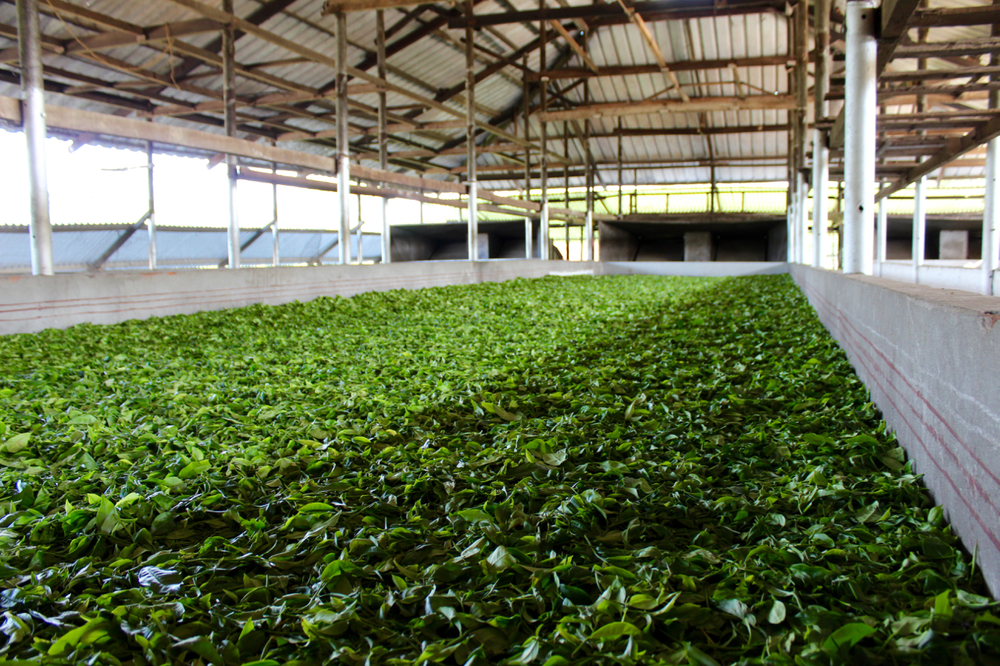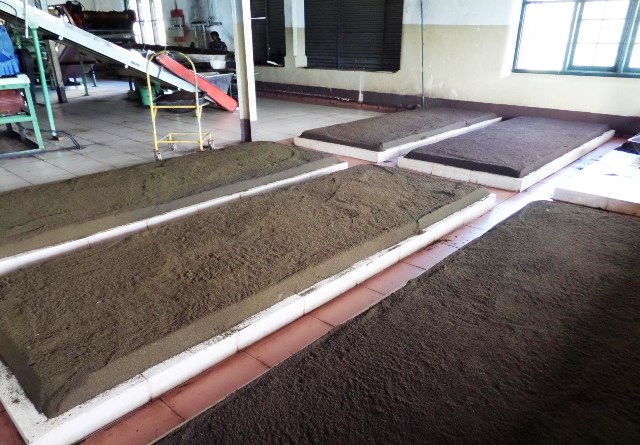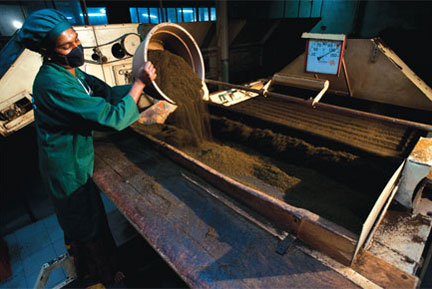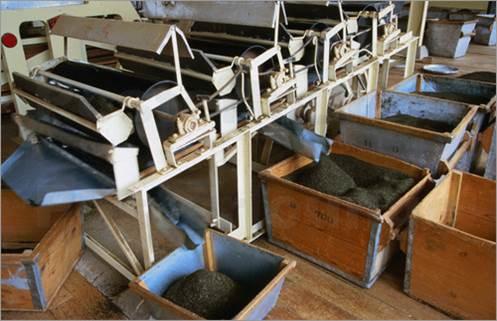Plucking
Harvesting fresh young shoots from mature tea bushes is known as plucking. Each pluck picks only two tender leaves and bud of succulent fresh growth. Within seven to ten days the bushes grow new shoots. Plucking is traditionally done by skilled women, adept at picking the shoots, and throwing handfuls into the carrier baskets resting on their backs. In Nilgiris temperate climate, tea is a perennial crop.
Withering
When tea leaves are plucked from the bushes, the moisture content is about 75%, and is then reduced to approximately 45%. The fresh leaf is spread out on withering troughs about a foot deep and a flow of cool air helps reduce moisture. This process can last from 8 to 18 hours depending on weather conditions. Significant chemical changes occur during withering. The cell membrane permeability is increased allowing for disruption of cell structure.
PURPOSE
Withering is the most critical process in black tea manufacture. The primary aims of withering are to reduce the moisture content of the leaf and to soften it, so it becomes pliable and will withstand the subsequent process of ‘rolling’, without breaking up into flakes. Additionally, controlled moisture extraction from fresh leaf is required to activate a series of bio-chemical reactions. These enzymatic changes are ultimately responsible for the production of various biochemicals desired for achieving quality parameters in made tea.
Rolling
Rolling of the withered leaf was perfected over centuries, a process which brings out flavour in tea. Rolling assists in establishing proper conditions for enzymatic oxidisation of the flavanols by atmospheric oxygen. This is achieved by disruption of cell structure which facilitates enzyme substrate contact.
PURPOSE:
The purpose of rolling is to achieve the final curved appearance and to break the leaf cell walls so as to release essential oils to start a chemical reaction of fermentation. The leaf is rolled several times. The first roll, known as the pre-conditioning roll is very gentle, of which the aim is to cover the twisted particles with the juices from the leaf. The rolling process is what releases the colour, strength, aroma and the taste of the liquid we ultimately pour into our cups.
CHEMICAL REACTION:
When the leaf cells are ruptured following the rolling of the withered leaf, the enzymes in the leaf come in to contact with the oxygen in the air which initiates chemical reactions that are necessary for the production of black tea.
ROLL-BREAKING:
Roll breaking has two primary objectives. To remove the twisted leaf off the rolled shoots that clogs and impedes circulation, and to facilitate further twisting action on the large leaf. Additionally, it also cools the leaf which would have risen in temperature during the process of rolling.
Fermentation
During fermentation, also known as Oxidisation, green leaf is converted to black tea. Although this is referred to as fermentation, it became recognised as oxidisation, a process initiated by the tea enzymes. This process starts at the onset of maceration during the rolling process, and it is allowed to continue under ambient conditions. The temperature of leaf is maintained at around 25-30 degrees. Mild acidification of the oxidised tea increases the levels of the tea theaflavins.
PURPOSE:
The finer particles collected after roll breaking are fermented to bring about the changes necessary to make a tea liquor palatable. This process can only take place when the cells of the tea leaf are properly ruptured. Here, in the coolness and darkness of the fermentation room, an oxidising enzyme produces brown products from the remaining water in the tannin. During this process, the green leaf is converted to black tea. Although this is referred to as fermentation it became recognised around 1901 as an oxidisation process initiated by the tea enzymes.
Firing & Baking
During this process, hot air is passed over the tea leaves to deactivate fermenting enzymes. Many organo-chemical processes are accelerated during this process, as are the enzymatic reactions before thermal inactivation. Firing also reduces the moisture level to 2-3%. This is critical as incomplete inactivation can cause accelerated deterioration of quality. There are several grades of tea, such as leaf grades, broken grades, fannings & dust grades.
PURPOSE:
The fermented leaf is dried to stop any further chemical reactions taking place. Passing hot forced air over the tea leaves deactivates fermenting enzymes. Many organo-chemical processes are accelerated during this period as are the enzymatic reactions before they are inactivated due to heat. Firing also reduces the moisture levels of the tea to 2 - 3%. This is critical as incomplete inactivation can accelerate deterioration of the tea during storage.
Sorting & Grading
Baked tea is sorted into different grades by passing them over a series of vibrating screens of different mesh sizes - lectrostatically charged rollers preferentially attract stalk and fiber to remove them from the tea.
PURPOSE :
The last operation in this long process of manufacture is the sorting and grading of the fired tea. Its importance cannot be overstated as it is here that the value of the final product is often determined.








